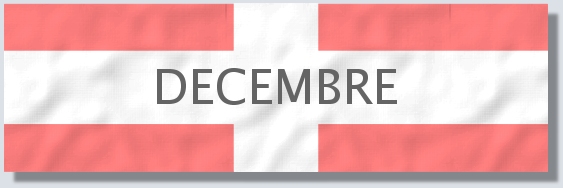|
The month of December brought a festival of lights, a visit from J, and another trip to Germany to spend the holidays with my parents. As with many European countries, the Christmas holidays are a magical time to be in France, and there is perhaps no nicer place than the Alsace. Fortunately, this most charming region was directly on the way between Chambéry and my parents' home.
|
|
|
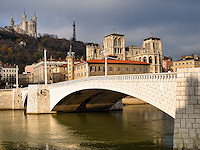
A view of Fourvière from the Saône
|
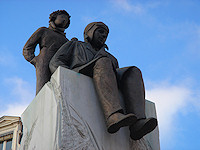
de Saint Exupéry and Le Petit Prince
|
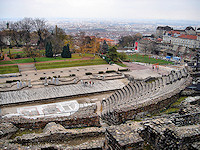
Roman amphitheatre on Fourvière
|
|
|
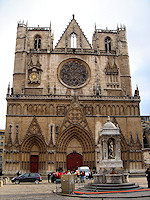
Cathédrale Saint-Jean-Baptiste de Lyon
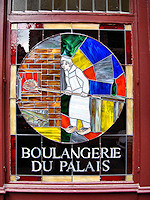
Stained glass on a bakery storefront
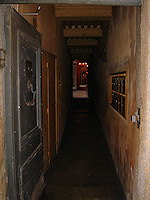
One of Lyon's many traboules
|
While surfing my five channels one evening, I happened upon the tail end of a news story about the upcoming Fête des Lumières in Lyon. The next morning I approached my friend at work to inquire about this Festival of Lights and whether it was something I should go see. He responded with a French version of the Yogi-ism that nobody goes to it because it is so crowded. Convinced that I shouldn’t pass up such a ringing endorsement, I made plans to attend on the coming Saturday but would get there plenty early to avoid the notorious crowds.
To date, I had not wandered much
further west than the Lyon airport during my travels.
I was quite looking forward to spending a glorious day visiting
one of France’s most famous cities. From the
beginning, Lyon had all the makings of an important city
– a hill overlooking the confluence of two major rivers
and situated along the historic route between north and
south. The Romans built the city of Lugdunum or ironically
meaning "hill of lights", and it soon grew to
become the capital of Gaul. Lyon received a major
boost when it was awarded a monopoly on silk production
by the French monarchy to ease its trade deficit with Italy.
To transport their goods to the rivers, the silk producers,
or canuts, used a network of some 400 passageways
called traboules which criss-crossed the city.
Lyon played a crucial role during World War II as it was
the center of power for the French Resistance during the
Nazi occupation. The traboules proved invaluable
to members of the Resistance in avoiding capture.
Jean Moulin, iconic leader and hero of the Resistance, was
not so lucky as he was captured in Lyon and interrogated
by the notorious Butcher of Lyon, Klaus Barbie. Moulin
would later die en route to a concentration camp from his
injuries received during torture. On a more pleasant
note, Lyon is renowned for the being the hometown of the
Lumière Brothers, fathers of French cinema, and also
the gastronomic capital of France - which is really saying
something.
Lyon is dominated by two hills -
the Fourvière which was home to the original Roman
settlement, and the Croix-Rousse where the silk mills pervaded
- prompting early locals to refer to the hills as "the
one where we pray" and "the one were we work".
I took the funicular to the summit of the Fourvière
to visit the Roman ruins and peak into the basilica of Notre
Dame de Fourvière, the latter giving a commanding
view of the city below. I opted to walk back down
via the steps and cross the Saône on one Lyon's thirty-odd
bridges. I explored the Croix-Rousse using some of
the traboules to get somewhat lost. It is
said that only a true Lyonnais knows his way around the
traboules and one must know the traboules
to be a true Lyonnais. I am not a true Lyonnais; however,
I did recover my bearings enough to find my way down to
the lower regions of the old city on the peninsula formed
by the Saône and Rhône. Just trying to
kill some time before nightfall, I wandered around some
of the parks and squares until I found myself a nice café
to wet my whistle with a Leffe or two.
|
|
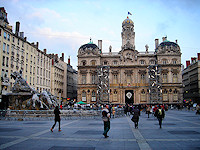
Lyon's Hôtel de Ville.
|
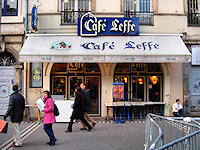
A good place to enjoy a Leffe or two
|
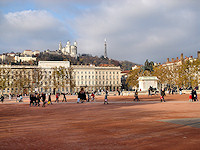
Place Bellecour
|
|
|
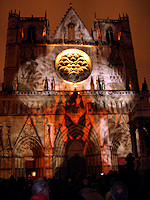
The cathedral was a main attraction.
|
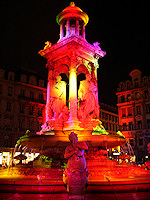
Fountain at Place des Jacobinss
|
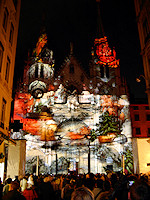
Saint-Nizier church
|

A light maze in one of the city parks
|
|
|
Having more than two Leffes can cause
problems for the rest of the night. In general, ordering
large beers (if you can find a place that serves something
more than a child's portion) or having more than two beers
seems to be frowned upon in France. It's as if ordering
a beer sends the message that you are there to get drunk.
Of course, they will serve you wine all day long despite
the fact it has double the alcohol content as beer.
Even the cafeteria at my company serves wine at lunchtime
- but never a beer in the middle of the work day.
Well I managed to make it to dark and still walk respectably out of the bar into the cold night air. I didn’t really have a plan or a schedule of events (if there indeed were events) so I just started walking. I turned the first corner and happened upon the Cathédrale Saint-Jean-Baptiste de Lyon where the face of the church was ablaze with lights and designs and music blared from unseen loudspeakers. I stood there for more than an hour watching the show, before I moved on across the bridge. Looking over my shoulder, the entire Fourvière was alight in ever-changing hues.
Ravaged for years by bubonic plague, desperate Lyon city officials decided to honor the Virgin Mary by making a candlelight procession up Fourvière in the hope that their city would be spared from additional suffering. It worked. And when they tried it again almost 200 years later during a cholera epidemic, it worked again. In 1852, a gilded statue of the Virgin Mary was to be unveiled atop Fourvière on 8 September, the day dedicated to celebrating the Blessed Mother. But flooding in the workshops caused the project to run late, and the date of the Festival of the Immaculate Conception (8 December) was chosen instead. To celebrate, the city's residents displayed lit candles in windows and placed torches outside buildings, and from these spontaneous acts, the Fête des Lumières was born.
I retraced many of the steps from earlier in the day, and at each turn there was some part of the citywide light show. Passing by an alley, I would catch a glimpse of a church or a municipal building with images projected on its façade. Houses displayed lights in their windows, the streets had decorative lighted displays, and almost each park or square had some sort of light show. My day in Lyon culminated in front of the Hôtel de Ville where an elaborate pyrotechnic show thrilled the crowds. |
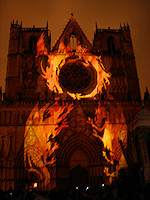
Dramatic music accompanied the light
show.
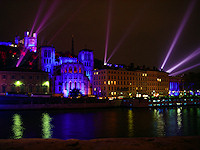
A view from the Rhône.
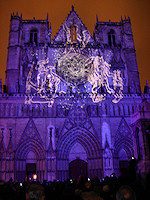
The crowd was transfixed
|
|
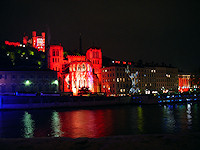
Projected images float across the
buildings.
|
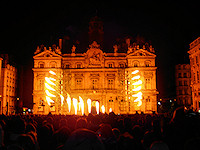
Pyrotechnics warm the crowds
|
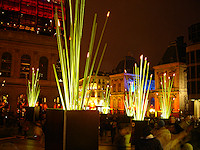
Light trees
|
|
|
|
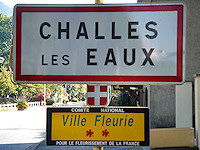
Communities proudly display their
ville fleurie status.
|
As the weather grew colder and the
days shorter, I reminisced through my photographs from when
I first arrived to brighten up my spirits. Each year, France
holds a nationwide competition to promote beautification
and tourism. Over a thousand communities compete to be named
as a ville fleurie (town in bloom) based on criteria
that include the amount and distribution of flowers within
the town, ground plantings compared to baskets and boxes,
the inclusion of regional flora, and community involvement.
Only a select few are awarded with the coveted quatre
fleurs (four flowers) grand prize. Standing out from
all others, Annecy has been awarded the quatre fleurs
every year since 1967 and has won the national grand prize
five times.
|
|
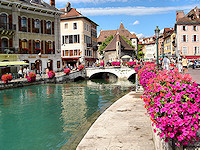
Annecy has a legendary record.
|
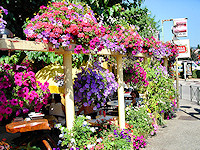
Contributions to Challes-les-Eaux's
honors.
|
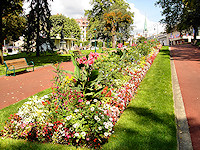
A flower bed in Aix-les-Bains.
|
|
|
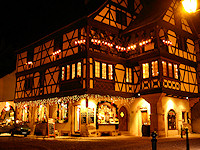
Quaint Alsatian half-timber house
|
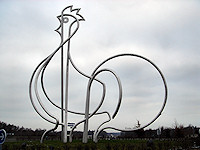
A reminder of who now owns the Alsace
|
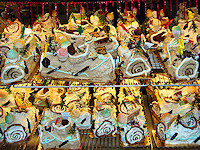
Les bûches de Noël
|
|
|
The plan for the holidays was to
collect J at the airport in Lyon and head directly up to
Germany for a family Christmas with my parents. Just
before New Years Eve, we were to join our favorite senior
citizen bus tour from previous trips to Lower Bavaria and
Montegrotto for a tour of Köln in the heart of the
Rheinland. Needless to say, J was suffering greatly
from sleep deprivation after spending some 11 hours in the
air. A long ride in the car was not going to keep
her awake for long, and by the time we reached Besançon,
she was slipping in and out of consciousness - sometimes
in mid conversation.
We had not planned to make the trip
all in one day, but instead made reservations for two nights
in a small hotel in Riquewihr where I had once visited in
my younger days during a family trip to the region.
This would give us at least a full day to experience some
of the Alsace at Christmas time. What makes the Alsace
special is its combination of French-ness and German-ness.
Politically, the Alsace has bounced around between France
and Germany a number of times as you might expect from a
border region between old foes. Culturally, the Alsatians
have a unique blend that draws from both countries.
Today, it is part of France although the architecture, cuisine,
and native language lean much more toward German.
Riquewihr, historically known as
Reichenweiher, exudes charm. The half-timber houses
lining the cobblestone streets give it that fairytale feel.
The whole town decked out for Christmas and was surrounded
by the vineyards that produced the grapes that yielded the
wine that provided the inhabitants with a stable income
for centuries. On some of the rooftops, you could
see the nests that were home to the indigenous Alsatian
storks. We went to the Christmas market and drank
some glühwein while checking out the stalls
selling ornaments and crafts. As night fell, the lights
came on to produce an even more magical feel. J began
to fade, so we ducked into an old restaurant to dine on
choucroute garnie - an assortment of grilled
meats with sauerkraut and potatoes - before turning
in for the night. Tomorrow, we needed to get an early
start to complete the drive to Germany. |
|
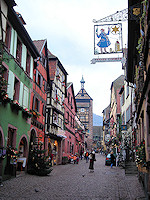
Downtown Riquewihr
|
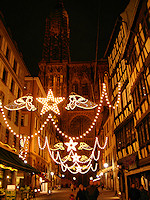
Strasbourg's Christmas market
|
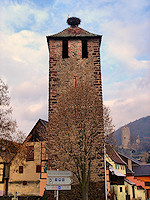
A stork nests atop one of the
town's watch towers
|
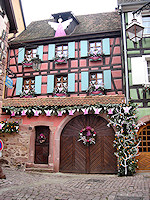
Decked out for the holidays
|
|
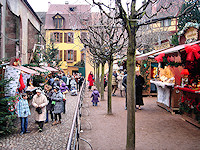
Riquewihr's modest Christmas
market
|
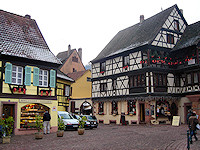
A small town square
|
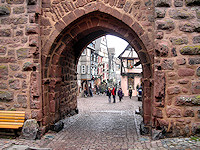
A city gate
|
|
|
